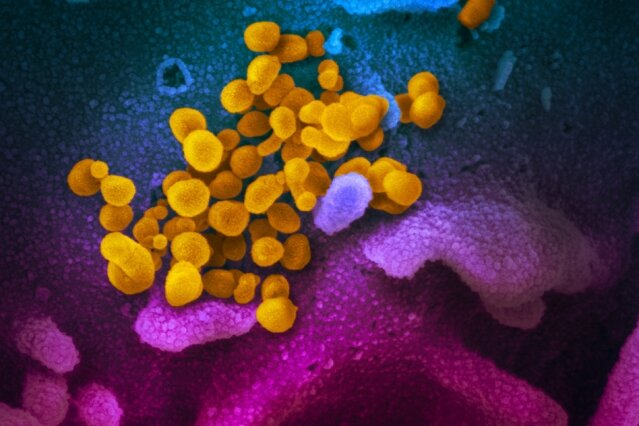 This scanning electron microscope image shows SARS-CoV-2 (yellow)— otherwise known as 2019-nCoV, the virus that causes COVID-19—isolated from a patient, emerging from the surface of cells (blue/pink) cultured in the lab. Image Credit: NIAID-RML
This scanning electron microscope image shows SARS-CoV-2 (yellow)— otherwise known as 2019-nCoV, the virus that causes COVID-19—isolated from a patient, emerging from the surface of cells (blue/pink) cultured in the lab. Image Credit: NIAID-RML
Researchers are developing a new nanoparticle coating which could severely limit the transmission of COVID-19 from various surfaces whilst simultaneously reducing the need for harmful chemicals.
Safe anti-viral nanoparticle coatings have demonstrated the potential to prevent active surface infection from SARS-CoV-2, researchers from Ben-Gurion University of the Negev (BGU) report. The coating which can be sprayed directly onto surfaces, is also effective in reducing bacterial infection, thus, giving it a wide range of potential uses.
The coating, which contains nanoparticles of safe metal ions and polymers with both anti-viral and anti-microbial properties, could have applications in hospitals and other healthcare facilities, as well as in locations such as schools, airports, and public transportation. The breakthrough could have particular ramifications for the fight against COVID-19, which has been shown to be capable of surviving on surfaces for up to 17 days.
The team, led by professor Angel Porgador, from BGU’s Department of Microbiology, Immunology and Genetics and the National Institute for Biotechnology in the Negev (NIBN), and Dr. Mark Schvartzman, from the institution's Department of Materials Engineering, measured the effectiveness of surfaces coated with a variety of different metals in blocking the HIV family lentiviruses from infecting human cells.
The research team, which also included Ph.D. students Yariv Greenshpan, Esti Toledo, and postdoc Guillaume Le Saux, found surfaces coated with copper nanoparticles significantly reduced the viral infection of cells.
The current coronavirus is transmitted not only through droplet spray but also via surfaces that can transmit the virus from one person to another. It is important to remember that we are developing coatings that will be effective not only against the coronavirus but also against other viruses, as indicated in our proof of concept experiments, and also against bacteria, so they will be relevant for a wide range of applications.
Professor Angel Porgador, Department of Microbiology, Ben-Gurion University of the Negev
Antiviral Ions
The coating developed by the researchers is based upon polymers consisting of nanoparticles of metals such as copper which can be painted or sprayed onto surfaces. Once applied to the surface the nanoparticles initiate the release of metal ions onto the surface.
Ions are atoms of a particular element which have had electrons stripped from them. Whereas atoms usually have a compliment of negatively charged electrons that balances the positively charged protons in their nucleus making them electrically neutral, ions have a diminished negative charge and thus carry a positive charge.
Previous research has indicated that ions, particularly those of copper, display effective antiviral activity against viruses such as influenza, herpes simplex and vaccinia virus, eradicating viral particles that can cling to surfaces.
The key to providing long-term protection against COVID-19, other viruses and bacteria, is delivered by the nanoparticles’ ability to slowly release the ions. This limiting property means that the coating can potentially be effective in reducing the infectivity of viruses tenfold for weeks, or even months.
Another benefit of the coating is the fact that it doesn’t use toxic or heavy metals and is thus not harmful to us. It could also potentially enable us to reduce the use of harmful chemicals as cleansing agents.
“While current surface disinfection methods rely mostly on substances that are poisonous for people, such as bleach, or on substances that evaporate readily being based on alcohol, the coating that we are developing is based on metals that are toxic for viruses or bacteria, but completely human friendly,” explains Schvartzman.
The researcher adds that up until recently using metals for anti-viral purposes has been challenging due to the tendency of these metals to oxidize and corrode, thus severely reducing both its effectiveness and its longevity. “Nanoparticles provide a solution to these obstacles,” Schvartzman continues.
Nanoparticles also provide another benefit over traditional metals. The fact that they can be spread very thinly over a large surface area means they can provide an effective anti-viral protection across a large surface whilst using a relatively tiny amount of metal.
Tackling the COVID-19 Problem from Different Angles
The nanoparticle coating research project is just one of 70 different initiatives underway at BGU that aim to tackle the COVID-19 pandemic.
These include diagnostic tests that can be carried out at home in under five minutes, and others which can identify asymptomatic carriers of COVID-19. Researchers at BGU are also working on antibodies which could potentially prevent SARS-CoV2 from invading hosts cells. This latter project also involves Angel Porgador and other researchers in BGU’s Shraga Segal Department of Microbiology, Immunology and Genetics.
As we get back to work, it will be imperative to leverage new solutions such as BGU’s new nanocoatings to ensure that we limit surface to human transmission. It is another fast-developing solution to challenges of the coronavirus pandemic at BGU.
Doug Seserman, Chief Executive Officer of American Associates, Ben-Gurion University of the Negev
Disclaimer: The views expressed here are those of the author expressed in their private capacity and do not necessarily represent the views of AZoM.com Limited T/A AZoNetwork the owner and operator of this website. This disclaimer forms part of the Terms and conditions of use of this website.